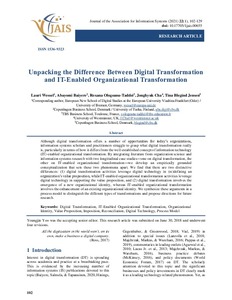Unpacking the Difference Between Digital Transformation and IT-Enabled Organizational Transformation
Cha Jonghyuk; Ologeanu-Taddei Roxana; Wessel Lauri; Jensen Tina Blegind; Baiyere Abayomi
Unpacking the Difference Between Digital Transformation and IT-Enabled Organizational Transformation
Cha Jonghyuk
Ologeanu-Taddei Roxana
Wessel Lauri
Jensen Tina Blegind
Baiyere Abayomi
Association for Information Systems
Julkaisun pysyvä osoite on:
https://urn.fi/URN:NBN:fi-fe2021042825449
https://urn.fi/URN:NBN:fi-fe2021042825449
Tiivistelmä
Although digital transformation offers a number of opportunities for today's organizations, information systems scholars and practitioners struggle to grasp what digital transformation really is, particularly in terms of how it differs from the well-established concept of information technology (IT)-enabled organizational transformation. By integrating literature from organization science and information systems research with two longitudinal case studies-one on digital transformation, the other on IT-enabled organizational transformation-we develop an empirically grounded conceptualization that sets these two phenomena apart. We find that there are two distinctive differences: (1) digital transformation activities leverage digital technology in (re)defining an organization's value proposition, while IT-enabled organizational transformation activities leverage digital technology in supporting the value proposition, and (2) digital transformation involves the emergence of a new organizational identity, whereas IT-enabled organizational transformation involves the enhancement of an existing organizational identity. We synthesize these arguments in a process model to distinguish the different types of transformations and propose directions for future research.
Kokoelmat
- Rinnakkaistallenteet [19207]
